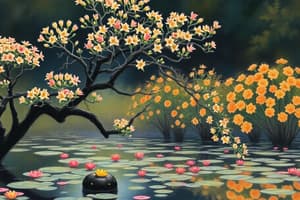Podcast
Questions and Answers
Which of the following is NOT considered a type of natural ecosystem?
Which of the following is NOT considered a type of natural ecosystem?
- Desert
- Forest
- River
- Aquarium (correct)
Which type of ecosystem includes both marine and freshwater categories?
Which type of ecosystem includes both marine and freshwater categories?
- Artificial ecosystems
- Terrestrial ecosystems
- Crop field ecosystems
- Aquatic ecosystems (correct)
Which option is categorized as a terrestrial ecosystem?
Which option is categorized as a terrestrial ecosystem?
- Garden
- Mountain (correct)
- Pond
- Zoo
What is a significant characteristic of artificial ecosystems?
What is a significant characteristic of artificial ecosystems?
Which of the following is a common misconception about ecosystems?
Which of the following is a common misconception about ecosystems?
What is a defining characteristic of an aquarium as an ecosystem?
What is a defining characteristic of an aquarium as an ecosystem?
Which group of organisms is responsible for consuming producers in the aquarium ecosystem?
Which group of organisms is responsible for consuming producers in the aquarium ecosystem?
What is the primary reason aquariums need to be cleaned regularly?
What is the primary reason aquariums need to be cleaned regularly?
Which of the following is NOT an abiotic component of an aquarium ecosystem?
Which of the following is NOT an abiotic component of an aquarium ecosystem?
How do natural ecosystems differ from aquariums regarding decomposers?
How do natural ecosystems differ from aquariums regarding decomposers?
What is the definition of an ecosystem?
What is the definition of an ecosystem?
Which of the following is NOT a biotic component of an ecosystem?
Which of the following is NOT a biotic component of an ecosystem?
Which abiotic factor does NOT influence the interactions in an ecosystem?
Which abiotic factor does NOT influence the interactions in an ecosystem?
What encompasses all external factors and substances surrounding an organism?
What encompasses all external factors and substances surrounding an organism?
Which of the following pairs correctly identifies an abiotic component?
Which of the following pairs correctly identifies an abiotic component?
Which organisms are classified as producers in an ecosystem?
Which organisms are classified as producers in an ecosystem?
What role do decomposers play in an ecosystem?
What role do decomposers play in an ecosystem?
Which of the following best describes primary consumers?
Which of the following best describes primary consumers?
Which statement is true about secondary consumers?
Which statement is true about secondary consumers?
In a food chain, where would tertiary consumers typically be located?
In a food chain, where would tertiary consumers typically be located?
Flashcards
Natural Ecosystems
Natural Ecosystems
Ecosystems that exist naturally without human influence, operating independently due to their own environmental factors.
Artificial Ecosystems
Artificial Ecosystems
Ecosystems created or significantly altered by human actions for specific purposes.
Terrestrial Ecosystems
Terrestrial Ecosystems
Land-based ecosystems that are characterized by their natural features like deserts, grasslands, forests, and mountains.
Aquatic Ecosystems
Aquatic Ecosystems
Signup and view all the flashcards
Human-managed Ecosystems
Human-managed Ecosystems
Signup and view all the flashcards
Producers
Producers
Signup and view all the flashcards
Primary Consumers
Primary Consumers
Signup and view all the flashcards
Secondary Consumers
Secondary Consumers
Signup and view all the flashcards
Tertiary Consumers
Tertiary Consumers
Signup and view all the flashcards
Decomposers
Decomposers
Signup and view all the flashcards
Aquarium Ecosystem
Aquarium Ecosystem
Signup and view all the flashcards
Consumers
Consumers
Signup and view all the flashcards
Abiotic Components
Abiotic Components
Signup and view all the flashcards
What are abiotic components?
What are abiotic components?
Signup and view all the flashcards
What are biotic components?
What are biotic components?
Signup and view all the flashcards
What is an ecosystem?
What is an ecosystem?
Signup and view all the flashcards
What is the environment?
What is the environment?
Signup and view all the flashcards
What is the difference between an ecosystem and the environment?
What is the difference between an ecosystem and the environment?
Signup and view all the flashcards
Study Notes
Ecosystem Types
- Ecosystems are classified into various types based on their location and characteristics.
- Natural Ecosystems: These ecosystems are naturally occurring, including forests, grasslands, deserts, and aquatic environments such as rivers, lakes, and oceans.
- Artificial Ecosystems: These ecosystems are created or modified by humans, such as crop fields, aquariums, and zoos.
Types of Ecosystems
- Terrestrial Ecosystems: These ecosystems are based on land. Examples include:
- Forest
- Grassland
- Desert
- Mountain
- Aquatic Ecosystems: These ecosystems are based on water. Examples include:
- Pond
- River
- Lake
- Ocean
- Freshwater Ecosystems: These ecosystems contain freshwater and include ponds, rivers, lakes.
- Marine Ecosystems: These ecosystems are saltwater based. Example oceans.
Components of Ecosystems
- Biotic Components: These are the living components of an ecosystem, including:
- Plants
- Animals
- Fungi
- Bacteria
- Abiotic Components: These are the non-living components of an ecosystem, including:
- Air
- Water
- Soil
- Temperature
- Rainfall
- Wind
Studying That Suits You
Use AI to generate personalized quizzes and flashcards to suit your learning preferences.




